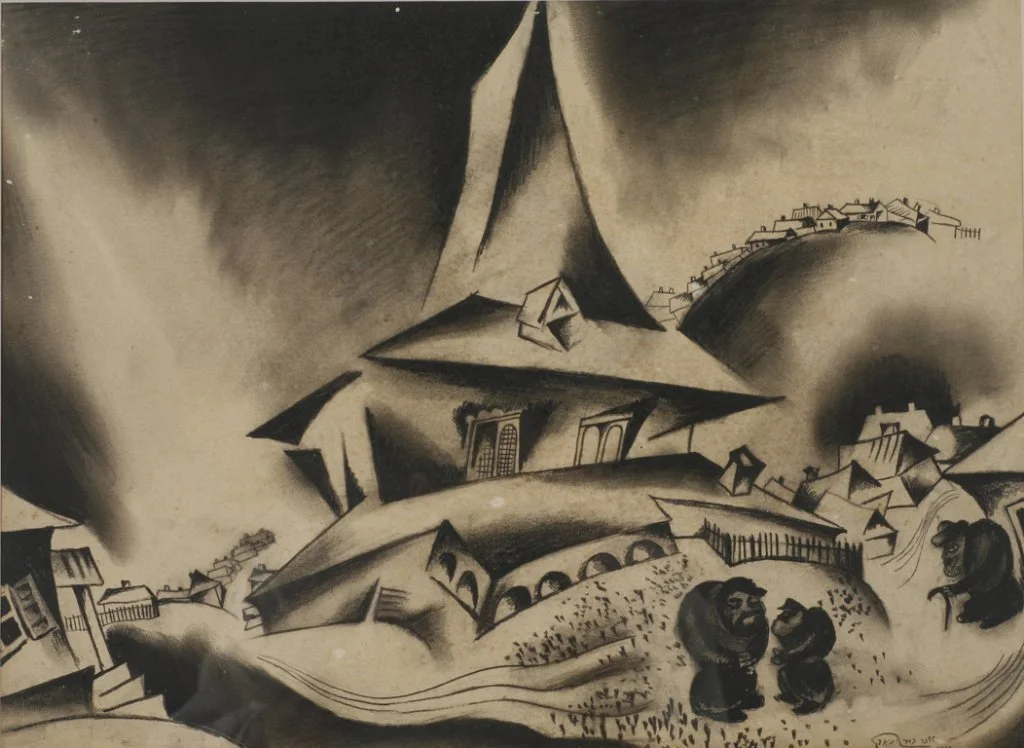Poetry & Art
ABOUT POETRY & ART OF THE WOODEN SYNAGOGUES
From Wikepedia:
Wooden synagogues were quite abundant, and several famous authors and artists include them in their works.
Adam Mickiewicz gives detailed description of wooden synagogues in his epic poem Pan Tadeusz, Or, the Last Foray in Lithuania; a Story of Life Among Polish Gentlefolk in the Years 1811 and 1812, first published in 1834.
The new inn made an uninspired impression;
The old one had been built in ancient fashion
Dreamed up by the carpenters of Tyre, and then
Spread through the world by the Jews—a style unknown
To architects in any other place.
The Jews it was who brought it here to us.
It's shaped like a ship in front, a temple behind;
The ship part is a Noah's Ark on land,
Or, as the vulgar say, a barn—a house
For sundry creatures (horses, oxen, cows,
Billy goats); while flocks of poultry dwell upstairs
With crawling insects too, and snakes in pairs.
The oddly formed rear section brings to mind
The Temple of Solomon on the Mount, designed
By Hiram's carpenters—who for their part
Had been the first to learn the builder's art.
Synagogues still are built this way; in turn,
Their shape is seen in that of inn and barn.
A roof of thatch and unplaned boards juts high,
Like a ragged Jewish hat, into the sky.
Above are long rows of wooden galleries
On moldering pillars that are mysteries
Of architecture—leaning to one side
Like Pisa's famous tower, still they abide,
Shunning, in fact, the models of Ancient Greece
For the pillars lack both capital and base.
They're topped with arches (also made of wood),
Half-rounded, copying the Gothic mode,
Formed not with burin or with chisel, but by
The carpenter's ax, deployed most artfully.
They curve like the arms of sabbath candlesticks.
At the end are knobs, a little like the box
That Jews strap to their foreheads when they pray,
Called "tzitzit" in their tongue.
— Adam Mickiewicz, Pan Tadeusz, Book IV (1834)
Napoleon Orda, renowned Polish-Lithuanian artist, painted at least two wooden synagogues.
Pohrebyszcze, 1872
Kamianiec,, 1876
El Lissitzky wrote about the murals in Cold synagogue in Mogilev after his and Issachar Ber Ryback's expedition:
The centerpiece of the whole place is the ceiling. On the western side, by the entrance, there stand giant lions and, behind them, peacocks. The lions hold two shields with inscriptions, the lower one is a memorial by the master for himself. Then there are three northern and three southern panels like a kind of frieze upon which unfurls the lives of predators and prey. Below there is water, upon it the earth, above the earth a sky; in the sky, stars that blossom into flowers. In the water—fish; they are being caught by the birds. On the earth a fox carries a bird in its snout. A bear climbs a tree looking for honey. Birds carry snakes in their beaks. All these flying things and running things—are people. Through their four-footed or feathered masks they look with human eyes. This is a very significant trend in Jewish folk art. Is that not a rabbinical face in the lion’s head in the zodiac paintings of the Mogilev Shul?
— El Lissitzky, On the Mogilev Shul: Recollections (1924)
"Jewish period" was very short in the art of El Lissitzky; on the contrary, for Issachar Ber Ryback everyday life of a Jewish shtetl became the foundation of his art. Ryback created several paintings of wooden synagogues, he probably was inspired for these works during the shtetl tour few years earlier.
The Synagogue in Dubrouna by Ryback (1917)
The Big Synagogue
Marc Chagall claimed that Chaim Segal, the artist who created murals in the Cold synagogue in Mogilev and several other synagogues, was his great-grandfather, and compares his own art to Segal's synagogue murals:
Jews, if they feel like it (I do), may cry that the painters of the shtetl wooden synagogues (why am I not with you in one grave) and the whittlers of the wooden synagogue rattles — "Hush!" (I saw it in An-sky's collection, got seared) are gone. But what is really the difference between my crippled Mohilev great-grandfather Segal who painted the Mohilev synagogue and me, who painted the Yiddish theater (a good theater) in Moscow? Believe me, no fewer lice visited both of us as we wallowed on the floor and in workshops. in synagogues and in theater. Furthermore, I am sure that, if I stop shaving, you would see his precise portrait...
By the way, my father [looked like him]. Believe me, I put quite a bit of effort, no less love (and what love!) have we both expended.
The difference is only that he [Segal] took orders for signs and I studied in Paris, about which he also heard something.
— Marc Chagall, Leaves from My Notebook (1920s)



